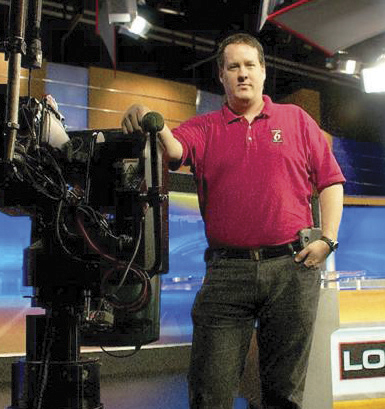Vinten Rademac Is Solid Performer at WKMG-TV

Rich Byrnes
ORLANDO, FLA.—Back in 2004, we installed three Vinten (now Vinten Radamec) SP-2000 robotic pedestals mounted with AutoCam HS-2010 Series robotic pan-and-tilt heads. We also installed an AutoCam HS- 105P robotic pan-and-tilt head mounted on a manual pedestal. All four cameras are operated fully robotically.
When we were evaluating robotic cameras 10 years ago, what put the Vinten AutoCam system over the top was that it allowed us to have separate control points. If one pedestal failed, the rest of the system could continue operating.
Originally we hooked the ACS200 Series controller to our Sony ELC automation system and let the Sony package operate our robotic cameras. However, we preferred to incorporate on-air camera moves, such as zooms or trucks, and now assign a robotics operator for each of our newscasts.
IT’S REALLY A CHESS GAME
Learning to run the Vinten Radamec system turned out to be very easy for new operators. I like to compare learning to operate our robotic cameras to learning chess—you need to know when you can move a specific camera, and what direction it can safely travel in.
We normally give a new trainee a full week of training with someone looking over their shoulder. The biggest challenge is getting them to think and run the system as though they were actually standing behind the cameras. Pedestal collisions do happen occasionally, and operators need to know how to recover quickly from a bumper hit.
We don’t have a “super user” per se; any one of our operators can create and save a new shot to the system. When a new shot or move is requested, the operator on duty will program it and rehearse it, if possible.
The professional video industry's #1 source for news, trends and product and tech information. Sign up below.
For camera moves, we set the shot at both ends of the move and let the control system itself interpret the move between points A and B. We don’t use the “motion” feature, as it takes too long to use on our timetable.
Since the robotics were installed, we’ve used them every day for both morning and afternoon slots. Even with a two-hour news block in the morning, our operators target the pedestals and make sure everything’s running properly, then we leave them in that mode for the next two hours.
We don’t do as many on-air camera moves in the morning as we do in our other newscasts; however, we usually open with a little pedestal move—or a zoom— and some little left-to-right trucks during the show. Our viewers have told us they like seeing these moves.
We initially used heavy studio-style Ikegami cameras with box lenses, but about a year ago these were replaced with Ikegami ENG-style cameras and lenses. Except for the need to add some weight at the rear of the cameras to counterbalance our prompters, everything continues to work the same as with the smaller cameras, just like it has ever since we first installed the system.
Rich Byrnes is the assistant production manager at WKMG-TV. He may be contacted atrbyrnes@wkmg.com.
For more information, contact Vinten Radamec at 203-929-1100 or visitwww.vintenradamec.com.
